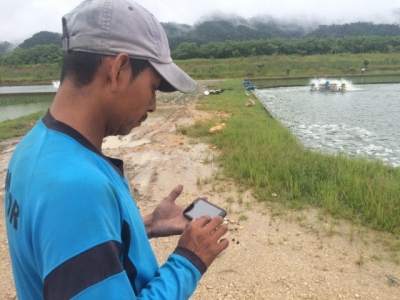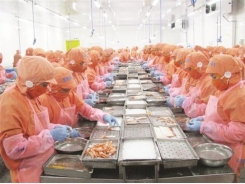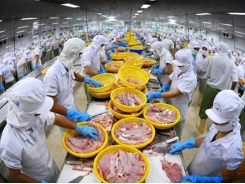Aquaculture data-collection app provides cloud coverage

Software from UK-based Aquanetix delivers real-time production reports
Aquanetix clients range from a small tilapia farm in the U.S. prison system to a multinational company based in India that annually produces more than 15,000 metric tons (MT) of fish.
Five years ago, two fish biologists consulting on aquaculture feed noticed that fish farmers using the product had significant gaps in the knowledge they needed to run their operations profitably and efficiently.
The farmers, they believed, were challenged to create production data that would analyze the impact of feeds on their production. They simply weren’t generating the kinds of reports they truly needed to improve their feeding procedures.
At the time, Diogo Thomoz was a fish biologist specializing in genetics while Stella Adamidou, a Ph.D. in fish nutrition, focused on growth and feeding models. The two realized that mobile technology could make this kind of data collection easier and more accessible for aquaculture operators. They were determined to create a cloud-based platform that would deliver precisely this kind of information.
They launched Aquanetix, a program delivering real time aquaculture management, in January 2015. The application employs cloud technology for electronic data collection, enabling farmers to monitor infrastructure, minimize feed losses and make informed operational business decisions based on real-time reports about their stocks.
“All you need is a smartphone, tabloid or computer and password to access the application,” explained Thomaz. He and Adamidou presented their business to potential investors at the Global Aquaculture Alliance’s annual GOAL conference last month in Dublin, Ireland, during a session titled, “On the Horizon: Meet Tomorrow’s Aquaculture Innovators.”
What we really need is market penetration, particularly in Asia, because aquaculture happens mainly in Asia.
“The data is securely stored and the farmer has complete access to and control over his business at any time,” Thomaz added.
To date, nearly 70 aquaculture farms worldwide, farming 30 different species of shrimp and fish, are using the software. The company’s clients range from a small tilapia farm in the U.S. prison system to a multinational company based in India that annually produces more than 15,000 metric tons (MT) of fish.
The advantage of Aquanetix is that it moves the burden of data collection to the farm workers, Thomaz said.
“They collect the data with a mobile app as they’re working, so the data they generate is more reliable,” he said. “It goes to the server in real time, is immediately processed, and is presented to the fish farmer as useful information enabling them to make management decisions.”

The Aquanetix application employs cloud technology for electronic data collection, enabling aquaculture operators to monitor infrastructure, minimize feed losses and make informed operational business decisions based on real-time reports about their stocks. Courtesy photo.
Up until now, collecting and analyzing these kinds of complex reports has been a laborious, time-consuming process for aquaculture farmers, he explained.
“Aquanetix delivers the best of what today’s aquaculture technology and science has to offer, giving aquaculture managers the time and freedom to focus on management,” Thomaz said. “They can deepen their understanding of feeding, production planning and risks of loss, get production alerts for mortalities and information on their equipment in a very simple way without having to set up servers or specialized equipment.”
Farm managers can do their planning on Aquanetix’ web application and their workers can see their recommendations for feed and quantities on their phone apps. The apps prompt workers to record information such as mortalities, the state of the fish and the state of the nets every time the fish are fed.
The cost of the software varies according to how much feed an aquaculture farm uses each year. Thomaz said a small trout farmer using 200 MT of feed would pay around $150 per month, while larger operations, using about 3,000 MT per year, would pay closer to $500 or $600 per month.
“Because the data comes in on our own servers, we can also offer our clients customized customer service,” he said. “For example, every week we alert our customers if they’re not performing their data entry correctly. We have an interest in making sure our customers use the software well, and we’re able to provide a level of custom support that no other company can.”
Aquanetix, based in the UK, has a staff of 10, but Thomaz is working on growing the sales force in number and efficiency, as well as trying to set up partnerships with companies specializing in feed, equipment, insurance and pharmaceuticals.
“These companies can potentially open their markets to us by – for example – buying Aquanetix in bulk and giving it to their customers,” Thomaz reasoned. “Our core product has been market tested for a while so we know it delivers good value. What we really need is market penetration, particularly in Asia, because aquaculture happens mainly in Asia. Everything else is a detail.”
About Author:
Lauren Kramer is a freelance journalist residing in Richmond, B.C., who has written extensively about seafood marketing for SeaFood Business magazine and SeafoodSource.com. Her work appears in a number of publications, including the National Culinary Review and Flavor & The Menu.
Related news
Tools

Phối trộn thức ăn chăn nuôi

Pha dung dịch thủy canh

Định mức cho tôm ăn

Phối trộn phân bón NPK

Xác định tỷ lệ tôm sống

Chuyển đổi đơn vị phân bón

Xác định công suất sục khí

Chuyển đổi đơn vị tôm

Tính diện tích nhà kính

Tính thể tích ao



 CPTPP, EVFTA to benefit Vietnamese fishery sector
CPTPP, EVFTA to benefit Vietnamese fishery sector  VietShrimp 2018 draws over 100 local, foreign businesses
VietShrimp 2018 draws over 100 local, foreign businesses